Thursday 23 March 2017
White: R. Thompson (137) - Black: K. Nevols (134)
A trip to a cricket pavilion. It is not a bad place to play chess - it is clean and quiet with parking. My opponent was the captain of the Kent under-140 team as well as my first opponent on my 'comeback' now a year and a half ago (Game One).
Both teams had qualified for the Fuller Cup semi finals - this match would decide who tops the group and thus plays at home.
1. d4 f5
A chance to play the Dutch defence. Here White avoids c4 and the fianchetto, and allows me to set up the classical Dutch defence set-up.
2. Bf4 e6
3. e3 Nf6
4. Nf3 d6
Playing 4. .. Be7 would have been more accurate. With the White bishop on f4 and pawn on e3, then it would be difficult for White to fianchetto his king's bishop - and when White does not put a bishop on the a1-h8 diagonal then Black should aim to do so. But b6 and Bb7 is harder to do after playing d6 due to the weakness of the white squares.
An idea might be 4 ... c6 with 5 . Qb6 exploiting the fact that White's dark-squared bishop has blocked itself off from the queenside.
5. Nbd2 Be7
6. h3 Nc6
As there is no threat of White playing d5, then I can put the knight on this square.
7. Bb5 Bd7
I was now concerned by 8. Ng5 but I think Black is OK after castling. (8. .. O-O 9. Bxc6 bxc6).
8. c3 O-O
9. O-O Qe8
Now I need to think about a plan and this move is a good contribution in order to take the queen into the kingside with the intention of initialising an attack.
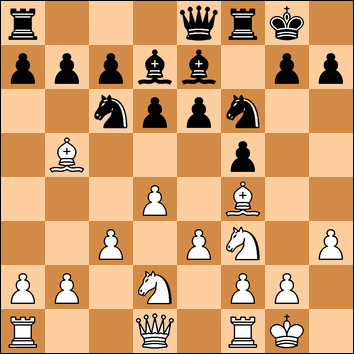
10. Re1
One rule of the Dutch, which I learnt from the Simon Williams DVD, is that, where possible, White must be prevented from playing e4 and opening the e-file. This move prepares that and so Black's reply stops this idea.
10. ... Ne4
Now 11. Nxe4 dxe4 12. Nd2 Qg6 is quite good for Black with the possibility of attacking with a well-timed e5.
11. Bd3 Qg6
12. Qc2 Nxd2
13. Qxd2 Bf6?!
Now e4 can no longer be stopped so I go to another rule from Simon Williams - that if you are unable to prevent e4 to make sure you can reply with e5. This move prepares that. But I forgot the loose bishop on d7.
I think 13. ... Qf7 or 13. .. Qh5 is better as White cannot play 14. e4 (14... fxe4 15. Rxe4 d5).
14. e4 e5
While White was thinking my heart skipped a beat as I saw 15. dxe5 dxe5 16. Bc4+ opening an attack on the bishop on d7. However on deeper investigation I saw that this does not lose material because Black can still attack White's pieces.
15. dxe5 dxe5
16. exf5
But I was quite relieved to see this move in case I had miscalculated somewhere.
16. ... Bxf5
17. Bc4+ Kh8
Now after 18. Nxe5 Nxe5 19. Bxe5 Black must not play 19. .. Bxe5 20. Rxe5 Bxh3?? (21. Rg5) and 19. .. Bxh3 20. Bg3 Bf5 21. Bxc7 simply loses a pawn.
Black must play 19. .. Rad8! where he can met 20. Qe3 with 20. .. Bxe5 21. Qxe5 Bxh3 regaining the pawn.
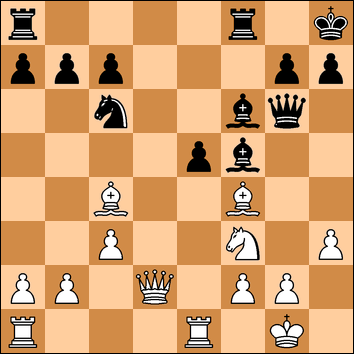
Instead White who goes wrong. He decides to leave the Black e-pawn on the board, which allows me to build up an attack around it.
18. Bg3? e4!
19. Nh2 Ne5
20. Bxe5 Bxe5
Whereas a few moves over I was worried about the two White bishops dominating the board, now it is the two Black bishops who are in charge. I want to bring my last rook into the fight.
21. Qe3 Rae8
22. Kh1 Bd6!?
A pawn sacrifice. My plan was 23. Qxa7 b6 and follow with .. Bc5. I hoped to lure his queen out of the game to gather time for an attack.
23. Nf1
OK, that didn't work.
23. .... b6
Both protecting the a-pawn but also planning Bc5, which White now prevents.
24. b4
Now best for Black is 24. .. a5 25. a3 Bd7! taking the opportunity to re-route the bishop and clear some space for Black's rook to advance down the f-file.
24. .... Re5
However White now has the chance to play 25. Ng3. I tried to see if I could get anywhere with 25. .. Bxh3 26. gxh3 Rf3 but there is nothing. White instead decides to cover the h5 square.
25. Be2 Bd7
Dropping back at last in order to focus down the f-file.
26. Nh2?
Better is 26. Ng3 - again blocking the g-file and hitting e4.
26. ... Ref5
This move is visually impressive (27. Qxe4 Bxh2 28. Kxh2 Bc6) but the computer says that 26. .. Rg5. If 27 Rg1 then 27. .. Rd5 with the threat of Bf4 trapping the queen - so 28. c4 Bf4 29. Qa3!? Rd2 or 29. Qc3 Be5 30. Qc2 Rd6 and Black is beginning to dominate the board.
However I have a combination in mind and, not for the first time, made a miscalculation.
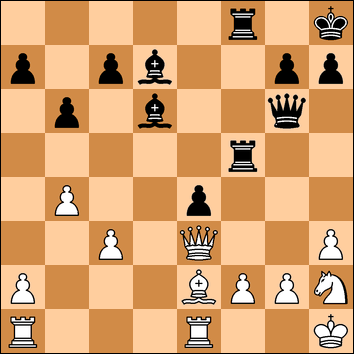
27. f3 Rg5
28. g4 Bxh2?
Bad. Black should play 28... Bc6. This gives away almost all of his advantage.
29. Kxh2
And now I realised I had miscalculated. The plan has been 29 .. dxf3 30. Bxf3 Rxf3 31. Qxf3 and then 31. .. Bc6 pinning the white queen. However I had overlooked that the last move had simply nudged the white king off that diagonal so that the queen would not be pinned.
Kicking myself again I now had to re-adapt in order to get the attack going again.
29. .... Qd6+
30. Kg2 exf3+
31. Bxf3
And now if 31. .. Rxf3 32. Qxf3 Bc6 White simply has 33. Kg1! - and the weakness of the back rank means that Black does not have time to take the queen.
Now with the foreboding thought that today would not be my day, I had to reorganise and see what happens.
31. ... Rg6
32. Rad1 Qe6
Forced. Now my thoughts were that the queens were now coming off and if I could get the rooks off too then it would be a drawn position and I could go home and try to find where I missed the win.
33. Qd3?
Now it is White's turn to go wrong. Like me, he seems to have thought that the queen exchange would be drawish and tries to exploit the lack of coordination amongst my pieces. However this overlooks that I could take a pawn.
33. ........ Qxa2+
34. Re2 Qf7
35. Rde1??
White blunders. He needed to play 35. Bd5.
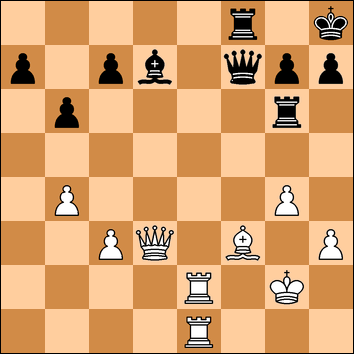
35. .... Rd6??
35. .. Bb5 wins on the spot. 36. Qxb5 Qxf3+ 37. Kh2 Rh6 or 36. Qd5 Qxd5 37. Bxd5 Bxe2.
I simply did not see this possibility.
36. Qe3 Re6?
Again missing 36. .. Bb5, this time with 37. Rf2 Rd3. (38. Be4 Qxf2+ 39. Qxf2 Rxf2+ 40. Kxf2 Rxc3 and two pawns up).
37. Qf2 Rf6
OK, now onto plan B ... or is it C? To exchange everything off and run with the passed pawn on the other side.
38. Re3
The computer recommends 38. Re7! Black would have to find 38. .. Qd5 and then 39. Bxd5 Rxf2+ 40. Kg1 c6 41. Rxd7 cxd5 42. Ree7 forces a draw.
38. .... Bc6
39. Rf1 Bxf3
40. Rxf3 Rxf3
41. Qxf3 Qxf3
42. Rxf3 Rxf3
43. Kxf3 a5
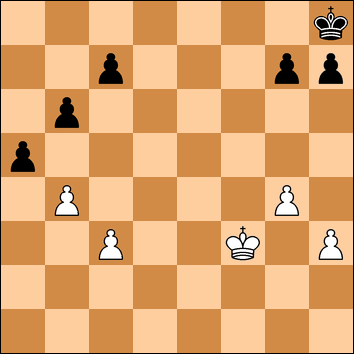
Now I had another horrible sinking feeling. Had I miscalculated? His king is closer to the centre. King and pawn endings are ferociously complicated and I consoled myself with the thought that if his king was able to round up the a-pawn then my king would have time to get over and should at least get a draw - which after all the twists and turns would have been a fair result.
My worries were allayed when he made one final mistake and allowed me to force and protect the passed pawn..
44. Ke3? a4
45. Kd3 b5
46. c4 c6
White now resigned. One continuation could be 47. Kd4 Kg8 48. cxb5 cxb5 49. h4 Kf7 50. g5 g6. White's king has to keep an eye on the a-pawn making a break for it and thus Black's king can just take the kingside pawns.
A tough battle with a lot of mistakes but I was pleased with the win which ensured we finished top of the group and avoid a trip to London.
Snodland v Swale
Robert Thompson (137) 0-1 Keith Nevols (134)
Jerry Pol (124) 0-1 Tyrone Jefferies (116)
Hugh Broadbent (99) 0-1 Andrew Gillard (113)
Richard Mallery (64) 1-0 Anthony Fletcher (74)
Snodland 1-3 Swale
No comments:
Post a Comment